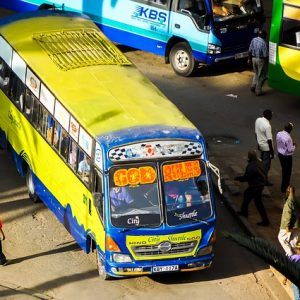By Corazon Achieng
We are standing in the middle of no man’s land in Westlands. The din of the touts trying to woo passengers can be heard beyond the uproarious vibration of the mechanical drill making its way into unknown depths. The working site is cordoned off with iron sheets and concrete pillars. Two policemen are manning the traffic. One of them has his head deeply buried in his smartphone. He is not wearing a mask. Many of the pedestrians walking by the site are roasting in the sweltering heat with their masks on.
On the edges of the site, hawkers have their wares on display. The rhythmic melody as they chant and call out customers is drowned in the cacophony of noises from the construction site. Pedestrians make do with whatever is left of the path that also drains a burst sewer pipe and provides space for bodabodas. A miscalculation can leave you covered in insults from the hawkers or raw sewage. Error and estimation which seemed irrelevant during "maths" lessons are applicable in this space.
The driver of the matatu I am traveling in is arguing with an old lady seated next to me. She wants to alight. The driver informs her that it is not safe. She insists that she does not want to miss her stop. The driver gets agitated and asks her to shut up. She responds by telling him that he is an idiot. The driver slams the brakes and orders the tout to throw her out. The rest of the passengers intervene and ask him to calm down. A woman in Juja lost her life earlier this year after she was thrown out of a matatu. Seven years ago, there was uproar in Kawangware over the death of a young lady who was thrown out of a moving vehicle following an argument over ten shillings. Eventually, the old lady alights, a couple of meters away from her stop.
The old lady’s stop has been a landmark in Westlands for years. There has been a sharp rise in the construction of skyscrapers within its vicinity over the last years. There is a showroom nearby that houses German machines; the kind that requires a lifetime of work or strolling by offices while tenders are falling from the sky. One of the top five audit firms in the country is housed next to the showroom. A few years ago, a man plunged to his death from the 17th floor of that building. This bus terminus is where the house helps, administrators, porters, wanna-be's, gardeners, nannies, data clerks, nurses, retail clerks among other mid and low-level professionals board matatus as they head home. A significant number of the matatus that are found here ply the Kangemi or Kawangare route.
Navigating walkways and public transport in this city is a combination of skill, talent, and luck. In addition to being a psychic, you need the agility of an athlete, the predictive acuity of an actuary, the wisdom of a street punk, and a phone that does not run out of charge. The inefficiencies and mishaps have become so intricately woven into the DNA of the public commuter system that it is impossible to recognize the system without them. I have lived long enough to know that there is no panacea for a problem as convoluted as the public commuter system. But, wisdom and empathy behoove me to attempt given a chance as the leader of Kenya.
As the road network in Nairobi continues to expand, bus termini remain an afterthought. Users of public transport find themselves walking for long distances along routes that were never meant to accommodate them in the first place. Research has shown that Kenya has a high fatality of pedestrians but data on the exact causes of fatalities is scarce due to poor investigation and reporting mechanisms. An observation of the acrobatic moves it takes to navigate the road as a pedestrian during road construction reveals the vulnerabilities that pedestrians and users of non-motorized are exposed to.
I would begin by ensuring that all road construction contracts have enforceable clauses which require contractors to provide safe, alternative routes. These alternate routes would be required to have well-marked bus termini and walkways for pedestrians. Provisions would be made for the disabled and cyclists on these routes as well as all roads within the city. This would be replicated across all the counties. Payment for completed road construction projects would be based on well-defined criteria. Failure to adequately cater to the plight of commuters and pedestrians during the road construction would attract a fine that would be deducted from the payment. The fines collected would go towards the creation of green spaces that would be open to the public for free. All existing roads would be modified accordingly to accommodate pedestrians. This would take various forms such as the inclusion of zebra crossings at appropriate locations, erection of barriers to deter encroachment, and construction of footbridges.
Research shows that 47% of the commuters in Nairobi walk to work. It is ironic there is little or no provision for them to participate in determining alternate routes. A participatory approach towards location of alternate routes would ensure that school children, the elderly, and the differently-abled are catered for on our roads. Having observed and learned from the wonder-working participatory approach in Makueni County, all counties would be required to employ this approach during road construction. Benchmarking is a costly hobby that is financed by overburdened taxpayers. To nip its egregious tentacles, the relevant ministries would develop training materials that would be availed for free on digital platforms.
I do not promise to change the world as the leader of Kenya because it is not mine to change. My desire is to make a difference by moving an inch that would ensure that movement within Nairobi and in this country is safe, efficient, and accommodative of all of us.
***
Corazon Achieng writes reflective essays and poems on the state of our world. Writing is how she processes the beauty and the brokenness of the world without loosing the tension that holds it true.




